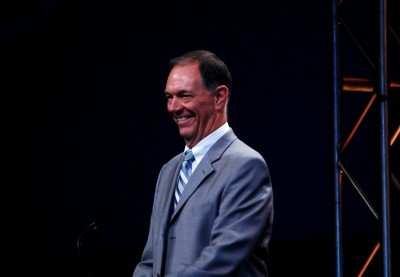Fri, Oct 21, 2011
New Facility Ready For NextGen
FAA Administrator Randy Babbitt was on hand Thursday for the
dedication of the new $72.6 million air traffic control tower and
radar approach control at Memphis International Airport. The new
tower enables air traffic controllers to continue to provide the
safest, most efficient service to both passenger and cargo
flights.

“This tower is a symbol of the FAA’s commitment to
aviation safety and modernization of the air traffic control
system,” said FAA Administrator Babbitt. “Our future
success depends on keeping our airport infrastructure healthy and
investing in NextGen so we can make air travel more efficient,
dependable and even safer.”
The new 336-foot-tall Memphis air traffic control tower is
equipped with state-of-the-art Next Generation Air Transportation
System, or NextGen, technology. The 850 square-foot tower cab has
enough room to accommodate additional future air traffic control
positions. The 24,000-square-foot base building houses training
rooms, administrative offices, and an expanded terminal radar
approach control (TRACON), with space for future growth. The new
facility has the latest seismic, security, and air traffic
simulation capabilities. Memphis Tower controllers handled 333,647
takeoffs and landings in 2010, making it the 22nd busiest tower in
the country. Memphis TRACON controllers handled 356,734 instrument
operations (overflights) in 2010, making it the 23rd busiest TRACON
nationwide.
The new facility has the latest radar, communications and
weather technology including:
- The Standard Terminal Automation Replacement System
(STARS), which provides air traffic controllers with
bigger radar displays on color monitors that are easier to read and
more detailed weather and flight information.
- ASDE-X: A ground radar safety system that
provides a high-resolution computerized display of aircraft and
vehicle movement on the airport surface. Memphis is one of 35
facilities to receive ASDE-X, which penetrates rain, fog and
darkness to give tower controllers a clear picture with which to
safely move aircraft around the airport. ASDE-X also updates
aircraft positions once every second.
- Integrated Terminal Weather System (ITWS): An automated weather
system that provides controllers near-term (0-30 minutes)
prediction capability of significant weather events including wind
shear, storm cell and lightning information.
- Collaborative Departure Queue Management
(CDQM): A key NextGen technology that shares real-time
data about the location of all aircraft and other vehicles on the
airport surface among controllers, pilots, airline operations
centers, airport operators and the FAA's Air Traffic Control System
Command Center. CDQM is being tested at Memphis Tower.
- Enhanced Traffic Management System (ETMS): The
system used by controllers to predict national and local traffic
surges, gaps, and volume based on current and anticipated airborne
aircraft. Controllers evaluate the projected flow of traffic into
airports and sectors, to determine and activate the best strategy
to ensure that traffic demand does not exceed system
capacity.
- Terminal Doppler Weather Radar (TDWR): A
sophisticated, high-resolution radar that detects all types of wind
shear in the airport terminal area. TDWR detects microbursts, gust
fronts, major wind shifts and precipitation intensity and displays
the information on a controller’s STARS displays. TDWR
enables air traffic controllers to provide pilots with specific
information on the location and strength of wind shear, with
sufficient advance warning to avoid it.
- Low-Level Windshear Alert System (LLWAS): the
system measures wind speed and direction at remote sensors located
around the airport. The remote sensor data is transmitted to a
master station, which generates warnings when windshear or
microburst conditions are detected.
More News
Aero Linx: International Business Aviation Council Ltd IBAC promotes the growth of business aviation, benefiting all sectors of the industry and all regions of the world. As a non->[...]
"During the annual inspection of the B-24 “Diamond Lil” this off-season, we made the determination that 'Lil' needs some new feathers. Due to weathering, the cloth-cove>[...]
Also: Bushcat Woes, Hummingbird 300 SL 4-Seat Heli Kit, Carbon Cub UL The newest Junkers is a faithful recreation that mates a 7-cylinder Verner radial engine to the airframe offer>[...]
Also: Seaplane Pilots Association, Rotax 916’s First Year, Gene Conrad After a decade and a half of struggling with the FAA and other aero-politics, G100UL is in production a>[...]
Also: Martha King Scholarship, Montaer Grows, Textron Updates Pistons, FlySto The FAA is hiring thousands of air traffic controllers, but the window to apply will only be open for >[...]
 ANN's Daily Aero-Linx (04.16.24)
ANN's Daily Aero-Linx (04.16.24) Aero-News: Quote of the Day (04.16.24)
Aero-News: Quote of the Day (04.16.24) Airborne 04.10.24: SnF24!, A50 Heritage Reveal, HeliCycle!, Montaer MC-01
Airborne 04.10.24: SnF24!, A50 Heritage Reveal, HeliCycle!, Montaer MC-01 Airborne 04.12.24: SnF24!, G100UL Is Here, Holy Micro, Plane Tags
Airborne 04.12.24: SnF24!, G100UL Is Here, Holy Micro, Plane Tags Airborne-Flight Training 04.17.24: Feds Need Controllers, Spirit Delay, Redbird
Airborne-Flight Training 04.17.24: Feds Need Controllers, Spirit Delay, Redbird



